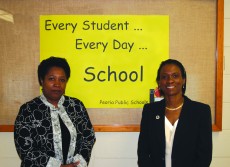Peoria’s Manual High School will begin a new chapter this fall, implementing the first steps in a major restructuring process as required by the federal No Child Left Behind Act.
After failing to meet federal requirements under the No Child Left Behind Act for five consecutive years, Manual High School must go through an extensive, mandated restructuring process. The list of guidelines a school must follow when restructuring is quite extensive, and because Manual is a Title I school—one in which at least 40 percent of the student body are from low-income families—there are even more requirements to fulfill.
Stepping up to the challenge, Peoria Public Schools District 150 brought in new administrators to facilitate the restructuring process. In speaking with two of those individuals—Dr. Sharon Desmoulin-Kherat, new principal of Manual High School, and Sandra Burke, Manual’s turnaround facilitator—we got an inside look at the process and reasoning behind the changes.
In a summary of Manual’s restructuring process, the district asserts, “The purpose of restructuring is to improve student academic achievement and enable the school to make adequate yearly progress as defined in the State’s accountability system.” Adequate yearly progress (AYP) is determined by each state and measures the progress school districts are making to ensure that each student meets or exceeds academic standards in reading and math. After five consecutive years of failing to make AYP, a school is required by law to make drastic changes in how it is run, specifically in terms of governance, curriculum and structure.
Studying What Works
To get the ball rolling at Manual, internal and external teams were formed. The internal team comprised
of District 150 and Manual High School administrators crafted a plan that was then sent to the state board. They also recommended utilizing a document entitled What Works When—a guide for education leaders produced by the Center for Comprehensive School Reform and Improvement—and convening an external team of 65 community members, parents and Manual staff members. Sandra Burke was hired to oversee the external team and facilitate the restructuring process, and Dr. Kherat was selected to serve as Manual’s new principal.
The District understood that the restructuring plan needed to be research-based—they had to study successful schools and learn from them. The teams chose to use a model called Talent Development High Schools (TDHS), initiated in 1994 at Johns Hopkins University in partnership with a high school in Baltimore. Since its inception, the model has been used by schools in 11 states.
Burke explained, “What [TDHS] brings to the table are the experience and successes in other high schools that are similar to Manual. It also brings a wealth of professional development.” Two commonalities were found in all of the successful models researched by the teams: the use of small learning communities and a curriculum focused on relevancy.
But simply implementing these things at Manual wasn’t enough, said Burke. “The external team made the recommendation for 7th through 12th grades [to be in one building] because they recognize that we need to start earlier.” In addition to small learning communities and a relevancy-focused curriculum, students need a firm foundation in reading and math. By housing all academies at the Manual High School location, it is hoped that communication among teachers, students,
parents and staff will improve, ensuring that students are where they should be in those subjects upon entering high school.
Small Learning Communities
In order to promote smaller learning communities, teachers, students
and parents will get to know each other better as looping is introduced—meaning students will have the same teachers as they progress through the new 7th and 8th grade Preparatory Academy, instead of getting new ones each year. The Preparatory Academy will lead directly into the 9th Grade Success Academy, with the hope that students will be less likely to drop out or get lost in the cracks in the transfer from middle to high school.
Parents and guardians will develop new roles within the Manual community, as they will be required to sign a parent compact indicating
their willingness and desire to work with their child(ren) as they progress through Manual’s academies. Parents are also required to meet with teachers at least once a month to stay abreast of their child(ren)’s progress. Personalized education plans will help teachers, staff and parents monitor each student’s progress and become aware of difficulties before they turn into larger problems.
To aid in improving parental involvement, Manual faculty and staff will be very flexible, providing numerous options to involve them in the school’s community. Dr. Kherat explained, “Parents tend to respond when they’re not placed in a box but are given opportunities to fulfill those requirements. I don’t anticipate a problem with that.”
Burke added, “Parents have been quite positive. [They] like the changes and feel that they’re a long time coming, so they have been very receptive to the ideas…It’s not punitive, it’s a partnership. Parents want their children to achieve; they want to see success…and are willing
to work with us to achieve that. That’s what a true partnership is.”
A Relevant Curriculum
After completing work in the 9th Grade Success Academy, students will be enrolled in a Career Academy of their choice. According to the recommendations, “Career Academies are school-within-a-school programs operating in high school grades 10 to 12. They offer career-related curricula based on a career theme, academic coursework and work experience through partnerships with local employers.” Students stay with the same group of teachers throughout their three years in the academy of their choice, continuing the small learning community experience they had in grades seven through nine. The career theme is not intended to prepare students for specific jobs, but to integrate curricula
and exposure to several careers and workplaces in a given field.
In order to facilitate the smooth operation of these Academies, the District recognizes that faculty and staff need to be given more opportunities
for professional development. Dr. Kherat emphasized that staff will be provided
with 90 hours of development, which will include training on how to work with children from low-income families and how to create individualized education plans for those who need extra help. Students who are not currently where they should be in terms of literacy and math skills will then receive the help they need to get there.
“My focus will be to concentrate on how instruction is delivered in the classroom,” said Dr. Kherat. “That must be done differently
at Manual. It cannot be lecture—it has to be engaging; it has to be differentiated.” According to Burke, another focus “is on the opportunity for teachers to come together to plan. Through the research we’ve done with Manual High School, we recognize how important it is that those teachers have time to look at that data, to continually assess the progress of the children and so forth, and how that impacts student achievement.”
Dr. Kherat emphasized the importance of establishing a culture of high expectation
within the school. “We are committed to the principle of rigorous academic curriculum, for sure. The nice thing is…we are building that curve and exposing them to rigorous curriculum and high expectations regardless of race, ethnicity and socioeconomic status.”
“People tend to—if you give them an option to take basic classes, that’s what they’re going to take,” she continued. “The adults need to challenge and encourage their people to say, ‘Hey, you can persevere with this—you can do it, and we’re going to support you.’” With that support, students will be empowered, not only to enroll in more challenging
courses, but to excel in them as well.
While Manual administrators, teachers and staff are moving in the right direction, Dr. Kherat said that it will take three to five years to see any real changes. The true test, she said, will come when the 2008-09 ninth graders take the Prairie State Achievement Exam during their junior year. Most of the immediate changes—such as the elimination
of basic, non-rigorous classes—will happen behind the scenes. Improved attendance and graduation rates, as well as lessened dropout
rates, will be better seen in a few years’ time.
While they may not be obvious to the public just yet, the changes being put in place at Manual High School are radical. The goal is to transform the school into a place where students excel, teachers do more than lecture and parents and community members aren’t merely bystanders, but participants in the culture and success of their students. The future of our city, nation and world sit in desks five days a week—it’s our job to empower them to become the leaders they are capable of being. iBi


 Sandra Burke and
Sandra Burke and